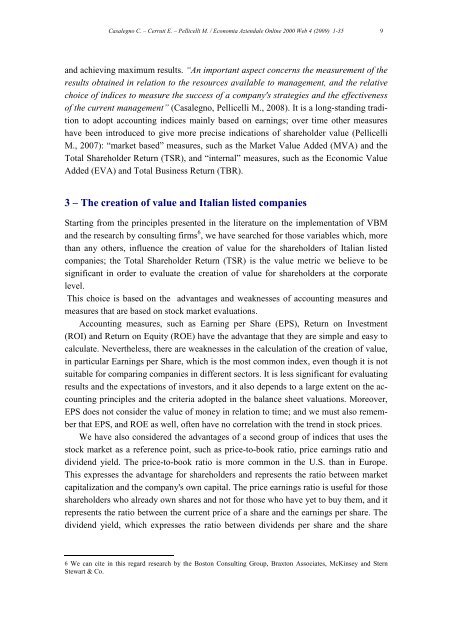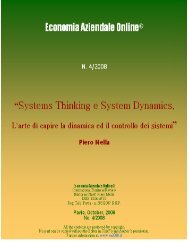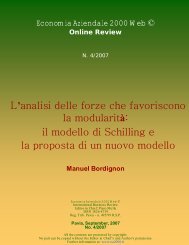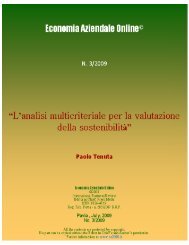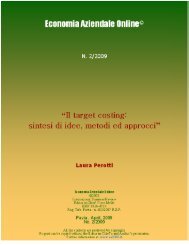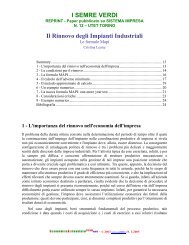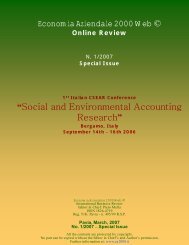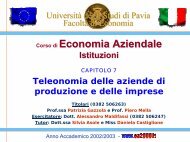Download this PDF file - Riviste
Download this PDF file - Riviste
Download this PDF file - Riviste
Create successful ePaper yourself
Turn your PDF publications into a flip-book with our unique Google optimized e-Paper software.
Casalegno C. – Cerruti E. – Pellicelli M. / Economia Aziendale Online 2000 Web 4 (2009) 1-35 9and achieving maximum results. “An important aspect concerns the measurement of theresults obtained in relation to the resources available to management, and the relativechoice of indices to measure the success of a company's strategies and the effectivenessof the current management” (Casalegno, Pellicelli M., 2008). It is a long-standing traditionto adopt accounting indices mainly based on earnings; over time other measureshave been introduced to give more precise indications of shareholder value (PellicelliM., 2007): “market based” measures, such as the Market Value Added (MVA) and theTotal Shareholder Return (TSR), and “internal” measures, such as the Economic ValueAdded (EVA) and Total Business Return (TBR).3 – The creation of value and Italian listed companiesStarting from the principles presented in the literature on the implementation of VBMand the research by consulting firms 6 , we have searched for those variables which, morethan any others, influence the creation of value for the shareholders of Italian listedcompanies; the Total Shareholder Return (TSR) is the value metric we believe to besignificant in order to evaluate the creation of value for shareholders at the corporatelevel.This choice is based on the advantages and weaknesses of accounting measures andmeasures that are based on stock market evaluations.Accounting measures, such as Earning per Share (EPS), Return on Investment(ROI) and Return on Equity (ROE) have the advantage that they are simple and easy tocalculate. Nevertheless, there are weaknesses in the calculation of the creation of value,in particular Earnings per Share, which is the most common index, even though it is notsuitable for comparing companies in different sectors. It is less significant for evaluatingresults and the expectations of investors, and it also depends to a large extent on the accountingprinciples and the criteria adopted in the balance sheet valuations. Moreover,EPS does not consider the value of money in relation to time; and we must also rememberthat EPS, and ROE as well, often have no correlation with the trend in stock prices.We have also considered the advantages of a second group of indices that uses thestock market as a reference point, such as price-to-book ratio, price earnings ratio anddividend yield. The price-to-book ratio is more common in the U.S. than in Europe.This expresses the advantage for shareholders and represents the ratio between marketcapitalization and the company's own capital. The price earnings ratio is useful for thoseshareholders who already own shares and not for those who have yet to buy them, and itrepresents the ratio between the current price of a share and the earnings per share. Thedividend yield, which expresses the ratio between dividends per share and the share6 We can cite in <strong>this</strong> regard research by the Boston Consulting Group, Braxton Associates, McKinsey and SternStewart & Co.


